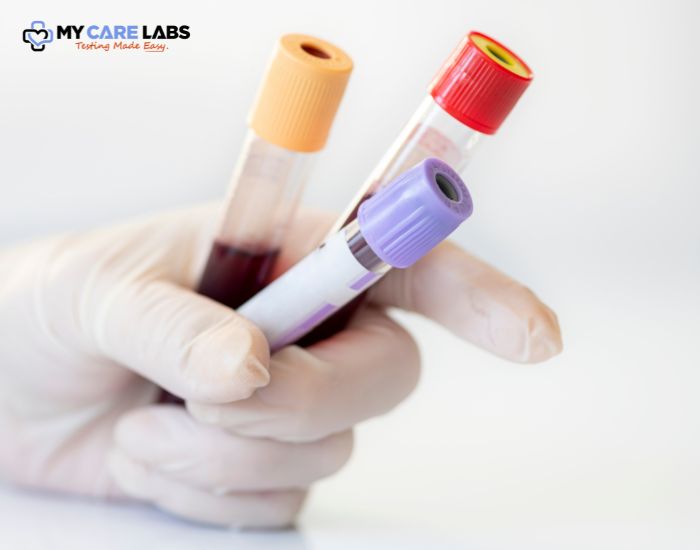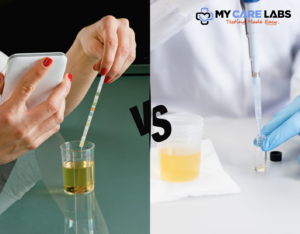A blood glucose test is a diagnostic procedure used to measure the concentration of glucose (sugar) in the bloodstream. This test is fundamental in assessing the body’s ability to regulate blood sugar levels, especially in the context of diabetes management. The results of a blood glucose test provide valuable insights into how effectively the body processes glucose, allowing individuals and healthcare professionals to make informed decisions about treatment plans, lifestyle modifications, and overall well-being.
1. Introduction to Blood Glucose Test
– 1.1. What is Blood Glucose?
Blood glucose, often referred to as blood sugar, is a type of sugar that circulates in the bloodstream and serves as a primary source of energy for the body’s cells. It is a crucial component of the body’s metabolic processes, providing the necessary fuel for various physiological functions. The level of glucose in the blood is tightly regulated to ensure a balance between energy supply and demand.
In normal physiological conditions, the pancreas plays a central role in regulating blood glucose levels. After a meal, the digestive system breaks down carbohydrates into glucose, which is then absorbed into the bloodstream. In response to the rising blood glucose levels, the pancreas releases insulin, a hormone that facilitates the uptake of glucose by cells for energy or storage in the liver and muscles.
Conversely, when blood glucose levels drop, the pancreas releases another hormone called glucagon, signalling the liver to release stored glucose into the bloodstream. This intricate balance between insulin and glucagon helps maintain blood glucose within a narrow range, ensuring a steady and sufficient supply of energy for the body’s functions.
Monitoring blood glucose levels is particularly important for individuals with conditions such as diabetes, where the body’s ability to regulate blood sugar is impaired. In diabetes, the normal insulin response is disrupted, leading to elevated blood glucose levels. Regular blood glucose testing is a key component of diabetes management, allowing individuals and healthcare professionals to make informed decisions about treatment, diet, and lifestyle to maintain optimal health.
– 1.2. Importance of Blood Glucose Test
a. Diagnosis and Management of Diabetes:
– Early Detection: Blood glucose test is instrumental in diagnosing diabetes and prediabetes. By measuring the concentration of glucose in the blood, healthcare professionals can identify abnormal levels and intervene early. Early detection allows for timely initiation of appropriate treatment and lifestyle modifications, reducing the risk of complications associated with uncontrolled diabetes.
– Treatment Adjustment: For individuals already diagnosed with diabetes, regular blood glucose test are essential for monitoring and managing the condition. The results guide healthcare providers in adjusting medications, insulin doses, and other treatment plans to maintain optimal blood glucose levels. This proactive approach helps prevent both short-term complications (such as hyperglycaemia or hypoglycaemia) and long-term complications associated with poorly controlled diabetes, including cardiovascular issues, kidney disease, and nerve damage.
b. Lifestyle Management and Prevention:
– Personalized Nutrition and Exercise Planning: Blood glucose test provide valuable insights into how different foods and activities impact an individual’s blood sugar levels. This information is crucial for creating personalized nutrition and exercise plans tailored to an individual’s specific needs. For those with diabetes or at risk of developing the condition, understanding the effects of diet and physical activity on blood glucose helps in making informed choices for a healthier lifestyle.
– Preventive Health Measures: Regular blood glucose monitoring is not only beneficial for individuals with diabetes but also for those at risk of developing the condition. For instance, individuals with a family history of diabetes or those with conditions like gestational diabetes may undergo blood glucose test for early detection and proactive management. This approach empowers individuals to adopt preventive measures, such as maintaining a healthy diet, engaging in regular physical activity, and making lifestyle adjustments to reduce the risk of developing diabetes.
In summary, the importance of blood glucose test lies in their role as a diagnostic tool for diabetes, guiding the management of the condition, and facilitating personalized lifestyle choices for both treatment and prevention. Regular monitoring empowers individuals to take an active role in their health, contributing to better overall well-being and a reduced risk of complications associated with imbalanced blood glucose levels.
2. Types of Blood Glucose Tests
2.1. Fasting Blood Sugar Test
The fasting blood sugar test is a diagnostic procedure that measures the concentration of glucose in the blood after a period of fasting. This test is commonly used to assess an individual’s ability to regulate blood sugar levels and is an integral component of diabetes diagnosis and management. Here are key aspects related to the fasting blood sugar test:
1. Purpose of the Test:
The primary purpose of the fasting blood sugar test is to evaluate how the body processes glucose after an overnight fast. By measuring blood glucose levels in a fasting state, healthcare professionals can identify abnormalities and diagnose conditions such as diabetes or prediabetes.
2. Preparation:
The test typically requires an overnight fast of at least 8 hours. This means refraining from consuming any food or beverages (except water) during this fasting period. The overnight fast provides a baseline for assessing how the body handles glucose without the influence of recent food intake.
3. Procedure:
A blood sample is collected, usually in the morning after the overnight fast. This can be done through a simple blood draw from a vein in the arm or, in some cases, through a fingerstick. The collected blood sample is then analysed to measure the concentration of glucose.
4. Interpretation of Results:
Normal fasting blood sugar levels typically range between 70 and 100 milligrams per decilitre (mg/dL). Elevated fasting blood sugar levels may indicate impaired glucose metabolism and can be suggestive of prediabetes or diabetes. Healthcare professionals use specific diagnostic criteria to interpret fasting blood sugar results.
5. Role in Diabetes Management:
For individuals already diagnosed with diabetes, the fasting blood sugar test is a key tool for monitoring and managing the condition. Regular testing helps healthcare providers assess the effectiveness of treatment plans, adjust medications if necessary, and make recommendations for lifestyle modifications to maintain optimal blood glucose control.
6. Importance in Preventive Care:
The fasting blood sugar test is not only diagnostic but also plays a crucial role in preventive care. Individuals with risk factors for diabetes, such as a family history of the condition or obesity, may undergo periodic fasting blood sugar tests as part of routine health check-ups. Early detection of abnormal blood glucose test levels allows for timely intervention and preventive measures.
In conclusion, the fasting blood sugar test is a vital diagnostic tool used to assess glucose metabolism and detect conditions such as diabetes. Its role extends to both the management of existing diabetes and preventive care for those at risk. Regular monitoring through fasting blood sugar tests empowers individuals and healthcare professionals to take proactive steps towards optimal blood glucose control and overall health.
– 2.2 Oral Glucose Tolerance Test (OGTT)
The Oral Glucose Tolerance Test (OGTT) is a diagnostic procedure that assesses the body’s ability to process glucose. After fasting, a glucose solution is consumed, and blood samples are taken at intervals to measure how the body metabolizes sugar. It is commonly used to diagnose diabetes and gestational diabetes during pregnancy.
– 2.3 Hemoglobin A1c Test
The Haemoglobin A1c test, also known as HbA1c or glycated haemoglobin, measures the average blood sugar levels over the past two to three months. It is a crucial tool in diabetes management, providing a long-term perspective on glucose control. The results guide healthcare decisions and adjustments to treatment plans for individuals with diabetes.
– 2.4 Blood Glucose Test during Pregnancy: Special Considerations
During pregnancy, blood glucose test are crucial for assessing gestational diabetes risk. The Oral Glucose Tolerance Test (OGTT) is commonly used, involving glucose solution intake. High blood glucose can affect both maternal and fatal health. Early detection allows for proper management, minimizing risks and promoting a healthy pregnancy.
3. Preparing for a Blood Glucose Test
Blood glucose tests require specific preparations to ensure accurate results and meaningful interpretation. Here’s a brief overview of key considerations:
3.1 Fasting Instructions
For certain tests, such as the fasting blood sugar test, an overnight fast of at least 8 hours is typically required. This helps establish a baseline blood glucose level, unaffected by recent food intake.
3.2 Medications and Blood Glucose Tests
Inform healthcare providers about all medications taken, as some may impact blood glucose levels. Adjustments or temporary discontinuation might be necessary before specific tests.
3.3 Blood Glucose Test Strips: Understanding Their Role
Blood glucose test strips are essential tools for self-monitoring diabetes. Coated with enzymes, these strips react with a blood sample to measure glucose levels when inserted into a glucose meter. Understanding their role is crucial for accurate at-home monitoring, guiding individuals in managing their blood sugar effectively.
In self-monitoring, test strips play a pivotal role. These strips, used with a glucose meter, enable individuals to measure their blood glucose levels at home. Understanding proper usage is crucial for accurate results.
3.4 Preparing for an OGTT
The Oral Glucose Tolerance Test (OGTT) may require specific dietary restrictions before the test, and fasting is often necessary. Following healthcare provider instructions diligently is crucial for accurate results.
3.5 Blood Glucose Test Non-Fasting: When and Why?
Some tests, like random or non-fasting blood glucose tests, do not require fasting. These tests provide immediate snapshots of blood glucose levels, often used in emergency situations or routine monitoring not dependent on fasting status.
Proper preparation enhances the reliability of blood glucose test results, aiding healthcare professionals in making accurate diagnoses and informed decisions regarding treatment plans.
4. Performing a Blood Glucose Test
Accurate blood glucose measurement is crucial for effective diabetes management. Here’s a concise overview of different methods:
4.1 Fingerstick Blood Glucose Testing: A User’s Guide
Fingerstick testing involves pricking the fingertip to obtain a small blood sample. Users apply the blood to a test strip, which is then inserted into a glucose meter for immediate results. This method is common for self-monitoring at home.
4.2 Venous Blood Sample Collection
In clinical settings, healthcare professionals often collect blood samples from a vein in the arm. This method provides a more comprehensive analysis of blood glucose levels and is commonly used for diagnostic and monitoring purposes.
4.3 Continuous Glucose Monitoring (CGM): A Technological Breakthrough
CGM systems use a small sensor placed under the skin to continuously monitor glucose levels throughout the day. Real-time data is transmitted to a device, offering a comprehensive view of fluctuations and trends in blood glucose levels.
4.4 Blood Glucose Monitoring Device: Choosing the Right One
Selecting an appropriate monitoring device is crucial. Factors to consider include accuracy, ease of use, data storage capabilities, and integration with other healthcare technologies. Discussing options with healthcare providers ensures a suitable choice for individual needs.
Choosing the right method for blood glucose monitoring depends on factors such as convenience, frequency of testing, and individual preferences. Understanding each method’s strengths and limitations empowers individuals to make informed choices for effective diabetes management.
5. Interpreting Blood Glucose Results
Understanding blood glucose results is essential for effective diabetes management. Here’s a brief overview:
5.1 Normal Blood Glucose Levels: Understanding the Numbers
Normal blood glucose levels typically fall between 70 and 100 mg/dL. These levels provide a baseline for health, indicating the body’s efficient regulation of glucose. Consistent monitoring helps individuals and healthcare providers establish personalized target ranges.
5.2 High Blood Glucose (Hyperglycemia): Causes and Management
Elevated blood glucose levels (above the normal range) may indicate hyperglycaemia. Causes include inadequate insulin, illness, or stress. Management involves adjusting medications, insulin doses, and implementing lifestyle changes. Regular monitoring helps prevent complications associated with prolonged hyperglycaemia.
5.3 Low Blood Glucose (Hypoglycemia): Recognizing and Responding
Interpreting blood glucose results empowers individuals to make informed decisions about their diabetes management. Regular communication with healthcare providers ensures personalized strategies to maintain optimal blood glucose control and prevent both short-term and long-term complications.
Blood glucose monitoring device for Blood Glucose Test
A non-fasting blood glucose test, also known as random or casual blood glucose testing, is conducted without the requirement for fasting beforehand. Unlike fasting tests that assess glucose levels after an overnight fast, non-fasting test provide a snapshot of blood glucose at any time during the day, regardless of recent food intake.
1. When and Why:
Non-fasting blood glucose tests are often employed in situations where fasting may not be practical or necessary. These include routine health check-ups, emergency medical situations, or ongoing monitoring of blood glucose levels throughout the day.
2. Procedure:
There is no specific preparation required for a non-fasting blood glucose test. A blood sample is taken at any time, regardless of the last meal. This sample is then analyzed to determine the concentration of glucose in the bloodstream.
3. Interpretation of Results:
Interpreting non-fasting blood glucose results involves comparing them to established reference ranges. Normal blood glucose levels in a non-fasting state can vary, but they generally fall within the range of 70 to 140 mg/dL.
4. Clinical Use:
Non-fasting blood glucose tests are particularly useful for individuals with diabetes who need frequent monitoring throughout the day. These tests provide immediate feedback on how lifestyle factors, such as meals or physical activity, influence blood glucose levels.
5. Considerations:
While non-fasting tests offer flexibility, they may not provide as comprehensive information as fasting tests in certain situations. For a more thorough assessment of glucose metabolism, healthcare providers may recommend fasting tests or other specialized tests depending on individual health needs.
Conclusion
In conclusion, the blood glucose test stands as a cornerstone in the realm of healthcare, playing a pivotal role in the diagnosis, management, and prevention of diabetes. Whether through fasting tests, oral glucose tolerance tests, or non-fasting assessments, understanding blood glucose levels empowers individuals and healthcare professionals alike.
The ability to interpret blood glucose results provides a roadmap for personalized diabetes management. Normalizing blood glucose levels through lifestyle adjustments, medication adherence, and timely interventions reduces the risk of complications associated with diabetes, fostering overall well-being.
Continuous innovations, such as continuous glucose monitoring (CGM) systems and advanced blood glucose monitoring devices, offer individuals unprecedented control and insights into their health. Choosing the right method for monitoring, whether through fingerstick testing or advanced technological solutions, enables tailored and effective diabetes care.
Moreover, the broader recognition of factors influencing blood glucose—diet, physical activity, stress, medications, and sleep—underscores the holistic nature of diabetes management. Acknowledging the interconnectedness of these factors allows for a comprehensive approach, emphasizing lifestyle modifications alongside medical interventions.
As we navigate the dynamic landscape of blood glucose testing, it is crucial for individuals to actively participate in their healthcare journey. Regular communication with healthcare providers, adherence to personalized treatment plans, and a commitment to a healthy lifestyle form the bedrock of effective blood glucose management. In essence, the blood glucose test is not just a diagnostic tool; it is a compass guiding individual toward proactive health choices.
By understanding and leveraging the insights gleaned from blood glucose testing, individuals can chart a course towards optimal health, minimizing the impact of diabetes and its associated complications.






